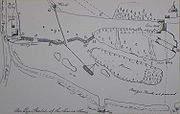
Flash lock
Encyclopedia

Lock (water transport)
A lock is a device for raising and lowering boats between stretches of water of different levels on river and canal waterways. The distinguishing feature of a lock is a fixed chamber in which the water level can be varied; whereas in a caisson lock, a boat lift, or on a canal inclined plane, it is...
were designed with a single gate, known as a flash lock or staunch lock. The earliest European references to what were clearly flash locks were in Roman times.
In England the "gate" was a set of boards, called paddles, supported against the current by upright timbers called rymers which normally kept the level of water above it to navigable levels. Boats moving downstream would wait above the lock until the paddles were removed, which would allow a "flash" of water to pass through, carrying the boats with it. Upstream boats would be winched or towed through the lock with the paddles removed. Considerable skill was involved both in removing the paddles in a timely manner and navigating the boat through the lock. Flash locks of this type have been documented since at least 1295 C.E.
Flash locks were commonly built into small dams or weir
Weir
A weir is a small overflow dam used to alter the flow characteristics of a river or stream. In most cases weirs take the form of a barrier across the river that causes water to pool behind the structure , but allows water to flow over the top...
s where a head of water was used for powering a mill. The lock allowed boats to pass the weir while still allowing the mill to operate when the gate was closed. However it could take up to a day or even more to restore the water levels after a boat had passed, so their use was unpopular with the millers.
Paddle and Rymer weirs
The weirs which are the remnants of flash locks can still be seen on the River ThamesRiver Thames
The River Thames flows through southern England. It is the longest river entirely in England and the second longest in the United Kingdom. While it is best known because its lower reaches flow through central London, the river flows alongside several other towns and cities, including Oxford,...
though they are not used any more for navigation as regular pound locks were introduced in the eighteenth and nineteenth centuries and the last flash lock removed in 1937. The Environment Agency
Environment Agency
The Environment Agency is a British non-departmental public body of the Department for Environment, Food and Rural Affairs and an Assembly Government Sponsored Body of the Welsh Assembly Government that serves England and Wales.-Purpose:...
is now involved in a programme of replacing these, claiming health problems, although the primary reason is probably operational efficiency.
Two or three paddles are placed between each of the rymers, which slot into a beam placed on the bottom of the river. The paddles are of differing lengths allowing a very fine adjustment of the amount of water flowing through the weir.
Three of these weirs, Rushey, Goring and Streatley have been Grade II listed, but the EA is proposing to replace most of Rushey, which would be the only full-width example left.

